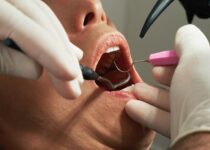Canker sores – Causes, Symptoms and Treatments
The canker sores are small ulcers superficial that form most often on the mucous membranes inside the mouth: on the inside of the cheeks, tongue, the inside of the lips, palate or gums. Canker sores can also appear on the genitals, but rarely. This will only deal with canker sores in the mouth.
When canker sores occur repeatedly, it is called aphthosis. The word stomatitis means that there is inflammation of the mucous membranes inside the mouth.
Mouth sores are common: about 17% of the population is affected at some point in his life. Often the first outbreak of canker sores appears during childhood. Then, the symptoms return at certain times and then disappear permanently during the thirties.
Canker sores can manifest themselves in a number of ways.
- Minor form: 1 to 5 oval-shaped ulcers (2 mm to 1 cm in diameter) that heal naturally in 7 to 14 days without leaving a scar. Canker sores appear in this form in 80% of cases.
- Major or bothersome form: larger ulcers (more than 1 cm in diameter), with an irregular outline, which can take 6 weeks to heal and often leave scarring.
- Herpetiform or miliary form: 10 to 100 tiny ulcers (less than 3 mm in diameter) with irregular outlines which gradually regroup, then form an ulcerative area, which persists for 1 to 2 weeks without leaving a scar.
Evolution
The pain usually lasts 2 to 5 days. However, ulcers may take 1 to 3 weeks to heal.
Diagnostic
A canker sore is a painful round or oval wound that occurs in flare-ups.
To make the diagnosis of canker sore, the doctor relies on several characteristics:
- the yellowish (“fresh butter”) or greyish background,
- the infiltrated base (you can take the canker sore between your fingers and you feel that the whole area is discreetly indurated),
- edges sharp and surrounded by a bright red halo.
When symptoms resembling those of mouth ulcers recur, it is best to consult a doctor. He will carry out a complete medical examination, which will allow him to make a diagnosis.
If, in addition to canker sores, redness in the eyes, joint pain, persistent diarrhoea or abdominal pain are present, it is important to consult without delay.
Canker-like ulcers can be caused by a chronic disease, such as inflammatory bowel disease (Crohn’s disease or ulcerative colitis), celiac disease, or Behçet’s disease.
In addition, canker sores can look like mucositis: an inflammation of the lining of the mouth that sometimes creates small lesions. People with weakened immune systems (due to HIV infection or cancer treatment, for example) are more likely to have ulcers that could be mistaken for canker sores.
Causes
The causes of aphthous stomatitis are not yet well established. Canker sores are not of infectious origin, therefore not contagious. Several factors, including heredity, could be contributing to this.
However, scientists have noted factors that tend to trigger symptoms in people with the condition.
A small wound inside the mouth. It can be caused by a bad fit of a dental prosthesis, by oral surgery, by too forceful use of the toothbrush, by biting of the cheek, etc.
Physical fatigue and stress. These often precede the onset of canker sores.
Food allergies or sensitivities. There is a link in the scientific literature between the recurrence of canker sores and food allergies or sensitivities (for example, to coffee, chocolate, eggs, nuts, cheese, highly acidic foods and preservatives, such as benzoic acid and cinnamaldehyde) 1-4.
A dietary deficiency of vitamin B12, zinc, folic acid or iron.
Smoking cessation. Canker sores can occur during smoking cessation.
An infection with the bacteria Helicobacter pylori, the same bacteria that can cause an ulcer in the stomach or small intestine.
Certain drugs. Nonsteroidal anti-inflammatory drugs (ibuprofen and others), beta-blockers (propranolol and others), and alendronate (against osteoporosis) can cause canker sores.
Hormonal changes related to the menstrual cycle, possibly. Canker sores tend to appear during menstruation, but this link is uncertain.
Note. Using a toothpaste that contains sodium dodecyl sulfate (called sodium lauryl sulfate ), an ingredient found in most toothpaste, could increase your risk of getting canker sores. It would make the inside of the mouth more vulnerable to injury by removing the protective layer that lines it. However, this hypothesis remains to be verified. A few small clinical trials suggest that the use of toothpaste without sodium dodecyl sulfate reduces the frequency of canker sores 5-7 . However, a more recent clinical trial concluded that the type of toothpaste used did not influence canker sores.
Symptoms, people at risk and prevention of canker sores
The canker sore outbreak is often preceded by a tingling sensation in the affected area.
- One or more small ulcers inside the mouth. The centre of the ulcers is whitish, and their outline is red.
- Canker sores cause a sharp pain comparable to a burning sensation (by the way, the word canker sore comes from the Greek aptein, which means “to burn”). The pain is accentuated when we talk or when we eat, especially during the first few days.
Remarks. Ulcers do not leave scars.
People at risk
- The women.
- People whose parent has or has had canker sores.
Prevention of canker sores
Measures to reduce the frequency of canker sores
- Have good oral hygiene. Use a soft-bristled toothbrush. Floss between teeth once a day. In addition, some studies have shown a reduction in the recurrence of aphthous stomatitis in sufferers who use antibacterial mouthwashes 15.
- Avoid speaking while eating and chewing slowly so as not to injure the oral mucosa. The lesions make the mucous membranes more vulnerable to the appearance of canker sores.
- Try to find out if you have food intolerances or sensitivities and, if necessary, remove the foods in question.
- If necessary, check with your dentist or denturist that the dental prostheses you wear are properly adjusted.
- Avoid using sodium dodecyl sulfate toothpaste, although this is controversial.
Medical treatments for canker sores
The sores usually heal on their own, so treatment is not always necessary.
- Mouthwash medication can relieve pain and inflammation. Some contain cortisone or prednisone, anti-inflammatory drugs, erythromycin, an antibiotic, viscous lidocaine, a local anaesthetic or diphenhydramine (Benadryl®), an antihistamine with an anaesthetic effect. These pharmaceutical substances also accelerate the healing of canker sores and prevent them from increasing in size. They can be obtained by prescription.
- An anaesthetic gel, ointment or liquid. Several types of products are found in pharmacies, over the counter. Applied to ulcers, they protect the mucous membrane and relieve pain. For example, Orabase®, Oralmedic® and Zilactin®, gels made from cloves (Pansoral®). You can also use sucking tablets (Aphtoral® combining Chlorhexidine / Tetracaine / Ascorbic acid). Other, more concentrated products can be obtained on prescription (Lidocaine gel). Other, more concentrated products can be obtained by prescription.
- Tablets of aspirin or acetaminophen (Tylenol®, Acet®, Tempra, etc.) can also help relieve pain.
- Be careful . It is better not to take nonsteroidal anti-inflammatory drugs (ibuprofen and others), which can contribute to the problem.
- Some medicines that were not originally intended to treat canker sores may be of benefit. This is the case, for example, with colchicine (a medicine usually used to treat gout). These drugs are taken orally in tablet form.
- For someone with very severe and recurrent canker sores, other treatments, such as oral cortisone , may be used , but this is rare given the side effects.
- If nutrient deficiency, corrected by taking supplements of vitamins or minerals .
If an ulcer is slow to heal, your doctor may suggest a biopsy. He then takes some tissue from the ulcer in order to examine it under a microscope. Analysis of the tissue will determine whether the lesion is cancerous or not.
Other tips for reducing pain
- Put an ice cube in your mouth and let it melt on the ulcer.
- Avoid consuming foods and drinks that irritate the mucous membranes. This is the case with those that are acidic (coffee, citrus, pineapple, tomatoes, etc.), hard (like toast, nuts and pretzels) or spicy.
- If rinse the mouth with one of the solutions following, and then spit it out:
- – 1 tbsp. baking soda and 1 tsp. of salt dissolved in 120 ml of water.
- – 1 C. of hydrogen peroxide in ½ liter of water (2 cups).
- These solutions reduce pain 9. Use 4 times a day if possible.
- Gently brush the canker sores with a little milk of magnesia a few times a day.
- Apply a thin layer of baking soda and water paste to the lesion.
You can see also:


